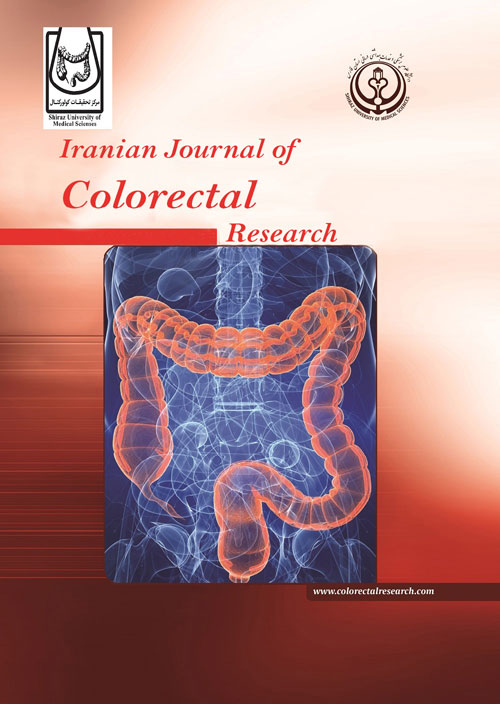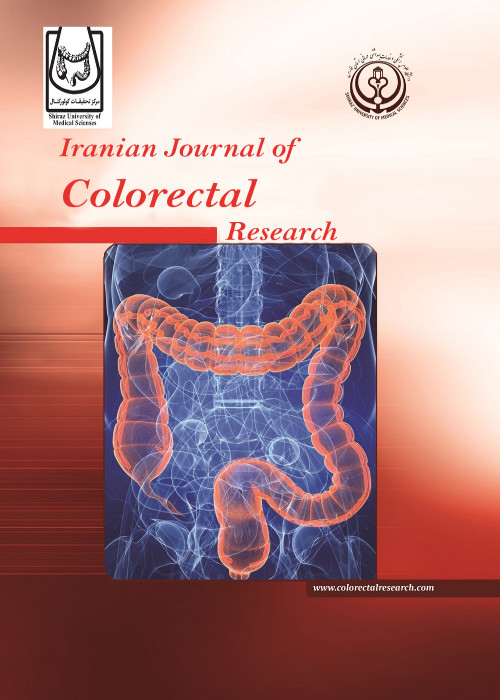فهرست مطالب

Iranian Journal of Colorectal Research
Volume:10 Issue: 2, Jun 2022
- تاریخ انتشار: 1401/06/29
- تعداد عناوین: 7
-
-
Page 1Background
Surgery is the mainstay of treatment for colorectal cancers. However, the effect of resection extent on patient’s function and quality of life (QoL) should be clearly assessed before surgery.
MethodsA retrospective study conducted on all consecutive patient with stage I-III colon cancer who underwent surgery at Department of Colorectal Surgery from January 2014 to January 2018. The EORTC QLQ-C30 was completed to assess functional capacity and quality of life in all patients free of recurrence.
ResultsThe study population consisted of 57 male (45%) and the mean ± SD of age was 57.7 ± 13.2 years. Most patients (54%) underwent total colectomy. The mean ± SD of interval between operation date and filling questionnaire date was 41.8 ± 6.9. There was no statistically significant difference between this interval period and type of surgery (p value: 0.76). However, it was revealed that as this period gets longer the score is higher (α: 2.3, CI: 2.1-3.9, p value=0.001). Multivariate analysis showed that after adjusting for T and N stage, age and gender, the type of surgical resection is an independent risk factor of having lower global health status(OR:3.2, CI:2.9-7.6, p-value=0.03), financial difficulties(OR:1.4, CI:1.1-3.6, p value=0.022) and higher rates of fatigue (OR:2.4, CI:1.8-4.6, p value=0.006).
ConclusionIt was found that as the larger segment of the colon is resected the worsening of global health status happens. So, the post-operative challenges toward coping with new functional capacity of resected bowel and QoL should be discussed with patient prior to surgery.
Keywords: Subtotal colectomy, total colectomy, Colon Cancer, Functional outcomes, Quality of life -
Page 2
The diagnosis and definition of irritable bowel syndrome is problematic. However, its existence as a disease entity has been recognised for at least a thousand years with both Rhazes and ibn Sina discussing the constellation of symptoms which make up thye syndrome. In recent times attention has focused on which symptoms and their duration are critical to the diagnosis. This work has been encapsulated in the reports of the Rome Foundation. The difficulties in disease definition have led to wide variations between reports on the condition’s prevalence in both within and between countries. Nevertheless, it is clear that irritable bowel syndrome is common across all societies. It is consequently of concern that allopathic medications are of limited benefit, particularly in the management of pain, and this has generated a growing interest in traditional therapies as well as hypnotherapy and acupuncture. This review touches on these issues and will hopefully stimulate further research.
Keywords: History, Symptoms, Pain, Epidemiology, alternative therapies -
Page 3Introduction
Acute intestinal obstruction (AIO) is a frequent and serious medical and surgical emergency. In developing countries, the aetiologies of AIO are dominated by hernia strangulation, whereas in developed countries, the main cause of obstruction is postoperative flange, which accounts for 40% of cases. The aim of the study are represented by the determination of the epidemiological profile of AIO in our institution. We were also interested in the morbi-mortality of this pathological entity and in the evaluation of the management.
Material and methodsThe inclusion criteria were all patients aged over 18 years with mechanical AIO operated in our institution during two years.
ResultsThe mean age of our patients is 61 years, with a sex-ratio of 1,4. There was 67% small bowel obstruction, and 33% colonic obstruction. The aetiology of small AIO is dominated by bridles in 53%, and that of a colonic cause by cancer in 72%. The computed tomography was used in 84,81% of cases. The mortality rate is 7,6% in all the series.
DiscussionOur results are similar to other series but the cancerous aetiology of AIO is twice as frequent as in the literature. In our series, especially in cases of bowel obstruction, we have noted a high rate of intestinal resection of around 70%, compared to 41% in an African study.
ConclusionThese results should call on the public authorities in our country to develop screening for colorectal cancers in populations at risk, in order to manage them in time.
Keywords: Diagnosis delay, Mortality, Prognosis -
Page 4Background
abnormal placentation occurs when the placenta adheres to the myometrium, instead of the decidua leading to what is nowadays known as the accreta spectrum. Risk factors the accreta spectrum include uterine scarring mostly related to previous cesarean sections, previous curettage, previous manual removal of a retained placenta, and endometriosis . Having said this, the incidence of abnormal placental adherence has been increased tenfold over the last 50 years which parallels the increasing rates of cesarean sections. Abnormally adherent placenta is classified according to its degree of invasion of the myometrium. When the placenta penetrates completely through the full thickness of the myometrium, it is classified as placenta percreta that possibly involves adjacent structures. Pelvic structures mainly the urinary bladder and the rectum are the most commonly involved structure. Furthermore and to a lesser extent, small bowel and the sigmoid colon may be involvedPlacenta percreta rarely invades pelvic or abdominal organs other than the urinary bladder or rectum. The optimal management of this condition is yet to be determined. For patients who wish to preserve their fertility uterine artery embolization has been employed in an attempt to decrease maternal morbidity and preserve fertility.
CaseHerein we present a case of 32 year old female patient presenting for low anterior resection of the colon due to invasion by placenta percreta left in situ.
ConclusionInvasion of sigmoid colon by the placenta percreta left in situ as part of conservative management of placenta percreta has never been reported in the medical literature. Multidisciplinary approach for its management is optimal represented by interventional radiologist, urologist, colorectal surgeon and obstetrician.
Keywords: Percreta Left in Situ, Invasion of the Sigmoid Colon, placenta percreta -
Page 5
Parkinson's Disease Dementia (PDD) is a cognitive and reasoning decline in many patients living with Parkinson's disease at least a year following diagnosis. PDD must be detected and treated promptly, as its advancement might impair the patient's quality of life. Alpha-synuclein deteriorates and extends to the limbic and neocortical regions in PDD, resulting in cognitive deficits. This development from PD to PDD may be associated with the quantity of aggregated alpha-synuclein in the colon. This also suggests employing the colonic alpha-synuclein cut-off concentration to detect the early progression of PD to PDD. Apart from concentration, the conformation of colonic alpha-synuclein can serve as a pathological hallmark. Despite the theoretical promise of colonic alpha-synuclein as an early diagnostic of PDD, the tissue sampling process may be a constraint. These restrictions, however, may be overcome with recent advancements in colonic biopsy technology. Thus, additional study is needed to close the information gap regarding using this biomarker as a possible early biomarker.
Keywords: diagnosis, Neurodegenerative, Digestive, Biopsy, Early detection -
Page 6Background
Physical activity is a fundamental health issue, How to educate it to patients and people in the community requires a set of knowledge and information about the sport, which should be achieved by physicians during college education. This study aims to compare the knowledge of Medical students with and without a training course about medical sport.
Methods180 medical interns from Shiraz University of Medical Sciences, both males (56%) and females (44%) students participated in this study. Sport and physical activity questionnaire (Mojab, 2008) was used. All the items were analyzed using SPSS version 22.
ResultsIndependent Sample T-test was applied to find whether there are similarities or differences between the interns with and without a course of sports medicine, and P<0.05 was considered statistically significant. Based on the obtained results the mean age was 25.75±1.38 years. The overall performance of the participants with a course in sports medicine (mean=9.75±3.12) was better than those without a course in sports medicine (mean=9.57±2.20). Although half of the participants passed a 3-hour course in sports medicine, no significant difference was found between the students’ knowledge without a course and those who passed a course in sports medicine (P=0.456).
ConclusionFindings show that these students lacked sufficient knowledge about the sport and were unable to prescribe a suitable sporting version for patients. So, it is suggested that medical education authorities prepare this field by providing at least one multi-day training workshop during the internship periud.
Keywords: Sports medicine, Medical student, Digestive diseases, Obesity, Physical Activity, Knowledge -
Page 7
A 56 y old woman who is known case of rectal cancer (T3N0) with previous history of surgery and chemo radiotherapy referred for evaluation of anemia. During her routine follow up visits, her oncologist informed about anemia (HB 10.2mg/dL, MCV 86fM), so request a full evaluation of GI tract including upper endoscopy and colonoscopy. She had not any complain except some fatigue and paleness. Her endoscopy was completely normal. During colonoscopy, the remained colon including site of anastomosis, descending, transverse, ascending and cecum sow completely normal but upon withdrawal of scope, there was brisk bleeding beside surgical sutures. The patient questioned about any bleeding and she mention rectal bleeding after sessions of rectal physiotherapy and rectal probe insertion for biofeedback therapy to prevent incontinence. So the cause of anemia diagnosed as rectal physiotherapy and biofeedback and the patient reassured and managed with intra venous iron (Ferinject 500mg). Her next follow up was totally normal without any complain.
Keywords: Rectal Cancer, Physiotherapy, Anemia


